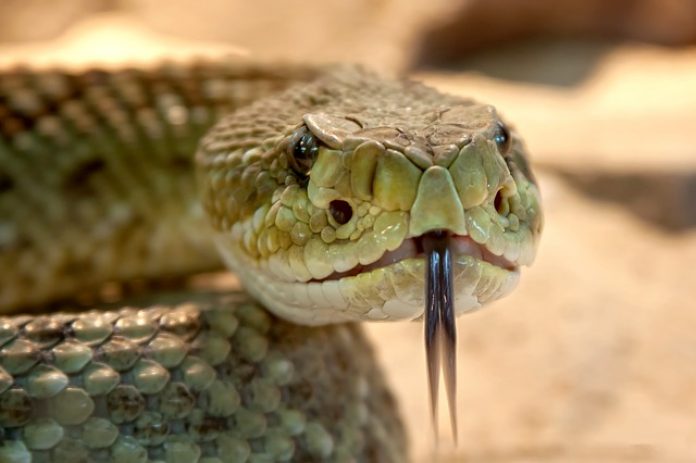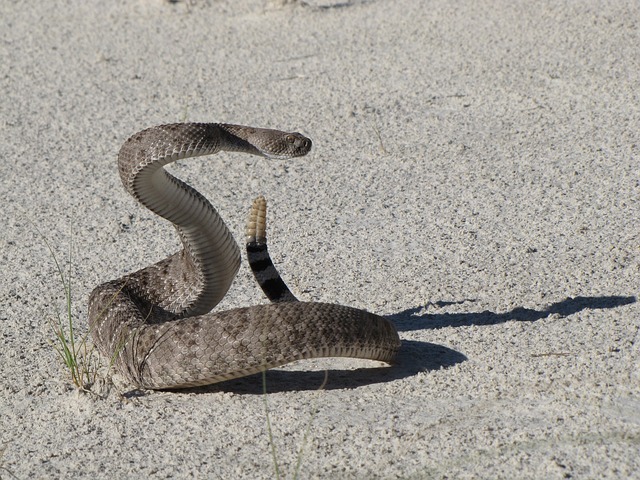Not many things make a seasoned hunter shake in their boots like the telltale sound of a nearby, but hidden, rattlesnake. Like an elephant standing in terror on a stool peering at a tiny mouse, the armed and capable hunter can find himself/herself frozen in fear of something they can’t even see over sagebrush. Unlike the elephant, the hunter’s fear is completely founded on truth. Rattlesnakes are scary. These slithering beasts can be found in every state with the exception of Alaska and Hawaii.
With over 20 different recognized species across the US, one might think an encounter would be quite common, but rattlers have incredible camouflage and like to come out at night. They fear and avoid humans as much as possible. This keeps most daytime adventurers out of their paths. Your chance of seeing one increases exponentially at dusk when the snakes come out of hiding to warm themselves on rocks and trails. This can pose quite a risk to hunters when they are headed back out of the field after shooting light has ended. It is wise to use a light to check the path in front of you or the base of the tree that your stand is hung in.
If you are hunting in rattlesnake country, not stepping or placing your hand somewhere that you cannot see will greatly reduce your chances of getting a nasty bite. Logs, cracks in rocks, and holes all provide common concealment options for rattlers. Snakes are known to frequent long grasses that tower over them and conceal them from the eyes of humans and predators alike. They will only strike a human when feeling cornered or threatened, preferring to save their venom for food.
If you do see a snake, simply leave it alone. Most bites occur when someone tries to catch, move, or kill a snake. Many states have laws protecting them, so killing them can have legal repercussions in addition to the danger. Wearing snake boots or gaiters that are puncture proof should be an essential piece of gear in the wardrobe of hunters who find themselves in rattlesnake country.
According to a University of Florida study, 85 percent of unprovoked bites occur below the knee. These bites are the ones that all of the other precautions could not prevent, so having that barrier might be the one thing left that could keep a great hunt from turning into a nightmare. Even if you take every precaution, there is still a chance you could get bit. It is easy to step within the striking range of a snake without even knowing it as they can strike within 2/3 of their body length.
Rattlesnakes will sometimes rattle as a warning, but that is not always the case. They may not realize you are there, or they may have stopped rattling as a warning because of their environment or the time of year. Hearing a rattle is not something you can count on, but it is definitely helpful if the snake is kind enough to oblige.
On a particularly hot August evening, my husband was walking along a deer trail at the top of a canyon. He had been out scouting for elk all afternoon and was headed back to the truck. The area he was in was not known to hold rattlesnakes and he had never seen or heard of one there before. In fact, rattlesnakes were the farthest thing from his mind as the tall grasses he was walking through swished with each purposeful step. The still, late summer air was calm and quiet. Suddenly, somewhere in the deep recesses of his mind, a sound was recognized. It registered and he responded in an instant by leaping to the side and off the trail as a rattlesnake flew through the air on his heels.
It happened so fast and without a total understanding of what had just happened. His buddy had been walking behind him and explained with a white face and large eyes that the snake had made the faintest rattle and only for a moment before lunging at my husband. His instincts had taken over, saving him from a gnarly bite. The snake then slithered off through the grass. There had been no warning and he had no reason to think a snake would be in that location. He was not wearing snake boots or gaiters, and the only thing that kept him from receiving a bite was his cat-like reflexes. Sometimes strange scenarios happen, and if they do will you be prepared and know what to do?
The first thing to remember is to stay calm. Obviously, that would be difficult to do but knowing that approximately 17% of rattlesnake bites are dry and have no venom injected could help. Even if venom is injected, thanks to anti-venom the odds are about 400 to 1 that you will live. That isn’t to say you won’t feel terrible for a few days, but it might help you remain calm.
Symptoms of snakebites include:
- Bloody wound discharge
- Fang marks or swelling at the wound
- Extreme localized pain
- Diarrhea
- Burning sensation
- Excessive sweating
- Fever
- Rapid heart rate
- Weakness of body
- Loss of muscle coordination
- Blurred vision
- Dizziness
- Nausea and vomiting
- Numbness or tingling
- Convulsions
- Fainting
If you have been bitten, call 911 immediately. The medical responders will need to know what snake bit you so they can administer the proper anti-venom. Without risking further injury, attempt to identify the snake or remember its appearance. No matter how far you are from medical treatment or cell service you must get to the nearest medical help because the only effective treatment is anti-venom. Once 911 has been called, or if you are out of cell range and have to hike out before you can call for help, follow these first aid instructions.
Do:
- Stay calm, still, and quiet. Restrict movement and keep the affected area at or below heart level to reduce the flow of venom.
- Remove any watches, rings, bracelets, and tight clothing as the affected area may swell.
- Allow the bite to bleed for 15 – 30 seconds before cleansing. Clean but don’t flush with water. Cover with a clean, dry dressing.
- Create a loose splint to help restrict movement of the bite area.
- Monitor vital signs – temperature, pulse, breathing rate, and blood pressure. Also, be aware of paleness.
- Watch for signs of shock (sweating, clammy skin, or shallow breathing). Often the fear of having been bitten is more dangerous than the bite itself.
- Attempt to identify the snake and its appearance.
Don’t:
- Don’t use a suction device or a snakebite kit. Contact medical help and follow the first aid instructions listed above.
- Don’t extract venom with your mouth.
- Don’t engage in strenuous activity. Slowly hike out without your pack to prevent over-exertion.
- Don’t apply a tourniquet. Restricting blood flow keeps the venom from spreading and cells are quickly destroyed by concentrated venom. You want it to spread so that the toxin is diluted and damage to the tissue is reduced.
- Don’t apply a cold pack. Cold reduces healthy circulation to the infected area and can cause you to lose a limb.
- Don’t eat or drink anything, including medication and alcohol.
Rattlesnakes are infamous and because of their reputation, there is a plethora of tales and legends about them. Some of them are true and some of them are myths, but they are all entertaining. After that solemn topic, I thought I would leave you with a few of them to lighten the mood.
- After being killed, rattlesnakes will continue to wiggle until lightning strikes.
- Placing a rattlesnake rattle into your fiddle will make it sound better.
- If a rattlesnake comes into your camp, burn it and all the other snakes will stay away.
- A snake fang inside the skull can still contain venom years after the snake has died.
- You can tell how old a snake is by counting the number of buttons on his rattle.
- Baby rattlesnakes are more dangerous than adults.
Many of the rattlesnake legends have been passed down from generation to generation, and folks hold to these stories as strictly factual. No matter what your impression of the rattlesnake, the truth remains that they are here to stay and will always be a part of the outdoors where we like to recreate. Learn how to avoid them and what to do if all your attempts at that fail. If we are aware and prepared, we can cohabitate with rattlesnakes easily enough. Watch your step!

















